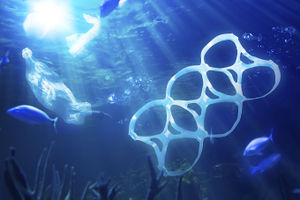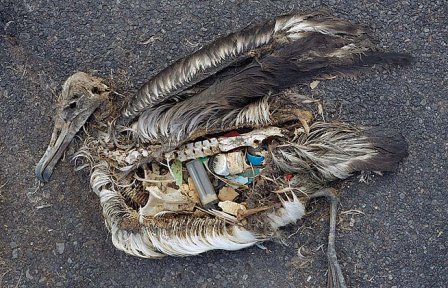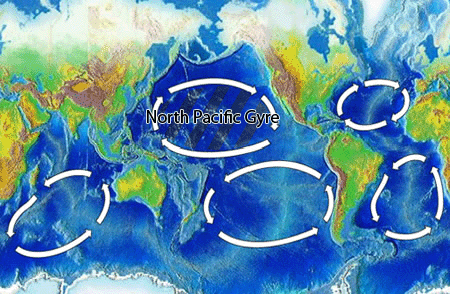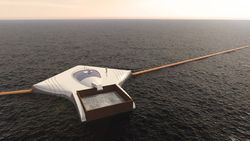Difference between revisions of "Plastics"
BrianNaess (talk | contribs) |
ShannonCash (talk | contribs) |
||
| Line 16: | Line 16: | ||
Known to Have Suffered from (n.d.): n. pag. United Nations Environment Programme. Greenpeace. Web. 4 Apr. 2015.</ref> Plastic debris can cause drowning, strangulation, suffocation, and starvation among marine wildlife. Among the animals most affected are sea lions an seals. It has been estimated that up to 58% of sea lions and seal populations have have been affected by entanglement due to litter in the sea. Remains of fishing net and lines have been reported to cut off flippers and scar dolphins, manatees, whales, and sea turtles. Up to 51% of seabird species are reported to be heavily affected by entanglement while 111 species are known to have ingested plastics. As plastic builds up in a bird's stomach, it creates the illusion that the bird it full, and thus fails to put on necessary fat supplies for reproduction and migration. Ingested plastic can block the digestive tract eventually leading to starvation. Up to 80% of sea turtles that are found dead are reported to have ingested plastic and other debris. Yet another concern is the ability of plastic to introduce alien species to a region. Because of plastic's ability to float very slowly - at a speed that could allow time for acclimation - small marine species could use the litter as an oceanic transport vehicle, introducing alien species to a non-native region.<ref name="unep">Allsopp, Michelle, Adam Walters, David Santillo, and Paul Johnston. "Plastic Debris in the World’s Oceans." Plastic Debris in the World’s OceansAt Least 267 Different Species Are | Known to Have Suffered from (n.d.): n. pag. United Nations Environment Programme. Greenpeace. Web. 4 Apr. 2015.</ref> Plastic debris can cause drowning, strangulation, suffocation, and starvation among marine wildlife. Among the animals most affected are sea lions an seals. It has been estimated that up to 58% of sea lions and seal populations have have been affected by entanglement due to litter in the sea. Remains of fishing net and lines have been reported to cut off flippers and scar dolphins, manatees, whales, and sea turtles. Up to 51% of seabird species are reported to be heavily affected by entanglement while 111 species are known to have ingested plastics. As plastic builds up in a bird's stomach, it creates the illusion that the bird it full, and thus fails to put on necessary fat supplies for reproduction and migration. Ingested plastic can block the digestive tract eventually leading to starvation. Up to 80% of sea turtles that are found dead are reported to have ingested plastic and other debris. Yet another concern is the ability of plastic to introduce alien species to a region. Because of plastic's ability to float very slowly - at a speed that could allow time for acclimation - small marine species could use the litter as an oceanic transport vehicle, introducing alien species to a non-native region.<ref name="unep">Allsopp, Michelle, Adam Walters, David Santillo, and Paul Johnston. "Plastic Debris in the World’s Oceans." Plastic Debris in the World’s OceansAt Least 267 Different Species Are | ||
Known to Have Suffered from (n.d.): n. pag. United Nations Environment Programme. Greenpeace. Web. 4 Apr. 2015.</ref> | Known to Have Suffered from (n.d.): n. pag. United Nations Environment Programme. Greenpeace. Web. 4 Apr. 2015.</ref> | ||
==Adaptations by Marine Life== | |||
Some marine species have been able to adapt to the pollution in their environment. However, these adaptations take a long time to reach the next generation and may lead them choosing survival over other vital factors, such as reproduction rates. Examples of fish adaptations include two species: the Poecillia Mexicana fish and the Killfish. Poecillia Mexicana fish have learned to survive in hydrogen sulfide polluted waters in Mexico. These fish lower their energy demands for survival, need less oxygen consumption, and grow in smaller sizes. <ref name="killfish">Page, Michael Le. “Fish Rapidly Adapt to Pollution Thousands of Times Lethal Levels.” New Scientist, 8 Dec. 2016, www.newscientist.com/article/2115635-fish-rapidly-adapt-to-pollution-thousands-of-times-lethal-levels/. </ref> Similarly, the killfish are able to live in extremely toxic, contaminated waters. The fish become more tolerant to toxins by making their receptors less sensitive to the current environment. However, mutating signal pathways and genes do not occur quickly-- it took at least 50 years for the killfish to be able to adapt their pathways to pass on to the future generation.<ref name="adaptations">Borowiec, Brittney. “How Animals Adapt to Polluted Environments.” Pacific Standard, 21 Nov. 2017, psmag.com/environment/animals-are-adapting-to-polluted-environments.</ref> | |||
==Degradation Times of Various Litter== | ==Degradation Times of Various Litter== | ||
Revision as of 20:01, 29 March 2020
Plastics and Other Litter
Overview
Plastic Production
In recent history, there has been a tremendous increase in the global production of plastic. In the 1950s, the annual production was 1.5 million tons. By 2011, that number had spiked to 280 million tons. [2] Because such a high percentage of this plastic is not disposed of properly, large quantities end up in the oceans around the world. Macroscopic plastic, the relatively little bit of plastic that is visible on the shore often fools people to think that the issue of debris and litter in the ocean is trivial, especially given the vastness of the oceans. However, the overwhelming majority of the plastic goes unseen as it gets trapped in oceanic currents, such as the North Pacific Gyre.
Chemical Make-ups and Effects of Plastic
Synthetic plastics are composed of polymers, or long chains of similar chemical units bonded together. These bonds are far too strong to be broken down by organisms, including through digestion. Instead, the plastic that ends up in the ocean photo-degrades, meaning the sun breaks down - but does not completely deteriorate chemically - the litter into smaller pieces, making animals and marine life more susceptible to mistake it for food. [3] While research on the topic has become a relatively recent topic of interest, we now know that some plastics, as they degrade, leach chemicals into the surrounding environment. The toxins are known as endocrine disruptors, a term that refers to "a hormonal imbalance initiated by exposure to a pollutant which leads to alterations in the development, growth, and/or reproduction in an organism or its progeny." [4]
Sources of Debris
It is estimated that roughly 80% of the litter in the ocean comes from land-based sources including tourist-related waste, sewage and street litter, and fishery related debris. The remaining 20% of oceanic litter is estimated to come from ocean-based means, including waste from ships and fishermen.[5]
Effect on Marine Life
Over 267 species of marine life have been documented to be harmed by litter in the oceans, either from entanglement or ingestion.
[5] Plastic debris can cause drowning, strangulation, suffocation, and starvation among marine wildlife. Among the animals most affected are sea lions an seals. It has been estimated that up to 58% of sea lions and seal populations have have been affected by entanglement due to litter in the sea. Remains of fishing net and lines have been reported to cut off flippers and scar dolphins, manatees, whales, and sea turtles. Up to 51% of seabird species are reported to be heavily affected by entanglement while 111 species are known to have ingested plastics. As plastic builds up in a bird's stomach, it creates the illusion that the bird it full, and thus fails to put on necessary fat supplies for reproduction and migration. Ingested plastic can block the digestive tract eventually leading to starvation. Up to 80% of sea turtles that are found dead are reported to have ingested plastic and other debris. Yet another concern is the ability of plastic to introduce alien species to a region. Because of plastic's ability to float very slowly - at a speed that could allow time for acclimation - small marine species could use the litter as an oceanic transport vehicle, introducing alien species to a non-native region.[5]
Adaptations by Marine Life
Some marine species have been able to adapt to the pollution in their environment. However, these adaptations take a long time to reach the next generation and may lead them choosing survival over other vital factors, such as reproduction rates. Examples of fish adaptations include two species: the Poecillia Mexicana fish and the Killfish. Poecillia Mexicana fish have learned to survive in hydrogen sulfide polluted waters in Mexico. These fish lower their energy demands for survival, need less oxygen consumption, and grow in smaller sizes. [7] Similarly, the killfish are able to live in extremely toxic, contaminated waters. The fish become more tolerant to toxins by making their receptors less sensitive to the current environment. However, mutating signal pathways and genes do not occur quickly-- it took at least 50 years for the killfish to be able to adapt their pathways to pass on to the future generation.[8]
Degradation Times of Various Litter
- Glass Bottle: 1 million years.
- Monofilament Fishing Line: 600 years.
- Plastic Beverage Bottles: 450 years.
- Disposable Diapers: 450 years.
- Aluminum Can: 80-200 years.
- Foamed Plastic Buoy: 80 years.
- Tine Cans: 50 years.
- Leather: 50 years.
- Plastic bag: 10-20 years.
- Cigarette Butt: 1-5 years.
- Apple Core: 2 months.
- Newspaper: 6 weeks.
- Paper Towel: 2-4 weeks. [10]
Great Pacific Garbage Patch
Located in the North Pacific Ocean between 135°W to 155°W and 35°N and 42°N is a mass of plastic known as the Great Pacific Garbage Patch. The existence of the Great Pacific Garbage Patch, or the Pacific Trash Vortex, was predicted by the Northern Oceanic and Atmospheric Administration (NOAA) in 1988 by scientists studying water conditions. [12] With the understanding of the oceanic currents and knowledge of the pollution, their hypothesis was proved correct, and in fact turned out to be more serious than originally believed. Since the area is not visible from satellite or air, it can only be estimated that the patch ranges from 270,000 sq mi to more than 5,800,000 sq mi (roughly one and a half times the size of the continental United States). This discrepancy is largely in part due to the obscurity between boundaries and the definition of what is considered to be a "high level" of pelagic debris, especially in a time when pollution and plastic in the oceans is omnipresent.
While its name may be misleading, the Great Pacific Garbage Patch is not actually a visible patch of floating garbage. In fact, one could sail through this area without being aware. Rather it is called this because of the exceptionally high concentrations of pelagic plastic - or plastic found in the pelagic zone of the ocean - that has been trapped in the currents of the North Pacific Gyre. A gyre is a vortex that slowly accumulates waste material because of the rotation of ocean currents and wind movements.[13] [12] Despite the relatively small size of these plastics, they are still known to have a dramatic impact on birds and other wildlife.
Current Ways to Reduce Litter in Oceans
While removing the plastic that is already in the oceans is going to be difficult, there are many ways that people around the world can reduce the amount of litter that ends up there. Some potential options are:
- Recycling plastic bottles and bags – Recycling these items means that they stay in circulation and out of the ocean. Reusing grocery bags or bottles reduces the need for them and can lower global plastic production.
- Decrease dependency on plastic – Carrying a reusable water bottle rather than using a disposable one can dramatically cut down on the amount of litter in the ocean. It is estimated that of all the disposable waters used, 80% of them become litter. Similarly, using reusable Tupperware or glass containers can reduce dependency on plastic bags.
- Increase penalties for littering in the ocean – Increased fines paired with proper enforcement can create incentive to properly dispose of waste.
- Manual removal of large pieces of debris – While this is not necessarily the most effective method, it can be used to clean up beaches and the surrounding areas, saving at least some wildlife.
Ireland's Successes
On March 4th, 2002, Ireland introduced a tax on plastic bags. The levy charged consumers 15 cents per bag at stores. Aimed to change the habits of consumers and decrease plastic bag usage, the tax proved to be exceptionally successful by decreasing an estimated 328 bags per capita to 21 bags per capita. On July 1st, 2007, the fee was increased to 22 cents per bag in an effort to further reduce the dependency.[14] The law does not make a distinction between biodegradable bags and non-biodegradable ones, due to the fact that biodegradable still take time to break down and thus could be dangerous to wildlife. Reusable shopping bags have now largely replaced Ireland's reliance on plastic bags. [15]
Potential Ways to Clean the Oceans in the Future
A discoverer of the Great Pacific Garbage Patch, Charles Moore, estimates that it would take 79,000 years to remediate the issue. Boyan Slat, however, a Dutch inventor and environmentalist, has come up with a way that, he believes, can use the oceans to clean themselves. In his TED Talk, he introduces a concept that would use oceanic currents to trap marine litter so that it can be collected and removed in just five years. By fixing 24 self-supportive floating platforms to the seabed, attaching nets between them, and allowing the gyres to carry the litter to nets, the trapped plastic could be retrieved and sold for more than the estimated cost of the project.[17]
Additional Teaching Materials
[[1]] --cited brochure
[[2]] --cited PPT
References
- ↑ https://achangingwildworld.wordpress.com/tag/plastic/
- ↑ Depledge, M.h., F. Galgani, C. Panti, I. Caliani, S. Casini, and M.c. Fossi. "Plastic Litter in the Sea." Marine Environmental Research 92 (2013): 279-81. Plastic Litter in the Sea. 3 Oct. 2013. Web. 3 Apr. 2015.
- ↑ De Wolff, Kim. "Gyre Plastic: Science, Circulation and the Matter of the Great Pacific Garbage Patch." Order No. 3670439 University of California, San Diego, 2014. Ann Arbor: ProQuest. Web. 19 Apr. 2015.
- ↑ Walker, Colin H. "Chapter 15: Endocrine Disruptors." Ecotoxicology: Effects of Pollutants on the Natural Environment. Boca Raton: CRC, Taylor & Francis Group, 2014. N. pag. Print.
- ↑ 5.0 5.1 5.2 Allsopp, Michelle, Adam Walters, David Santillo, and Paul Johnston. "Plastic Debris in the World’s Oceans." Plastic Debris in the World’s OceansAt Least 267 Different Species Are Known to Have Suffered from (n.d.): n. pag. United Nations Environment Programme. Greenpeace. Web. 4 Apr. 2015.
- ↑ http://www.mafab.hu/movies/muanyag-a-tengerek-valodi-reme-149593.html
- ↑ Page, Michael Le. “Fish Rapidly Adapt to Pollution Thousands of Times Lethal Levels.” New Scientist, 8 Dec. 2016, www.newscientist.com/article/2115635-fish-rapidly-adapt-to-pollution-thousands-of-times-lethal-levels/.
- ↑ Borowiec, Brittney. “How Animals Adapt to Polluted Environments.” Pacific Standard, 21 Nov. 2017, psmag.com/environment/animals-are-adapting-to-polluted-environments.
- ↑ http://newsroom.electrolux.com/es/2011/11/02/electrolux-premiada-por-la-onu-por-la-campana-vac-from-the-sea/
- ↑ "Time It Takes for Garbage to Decompose in the Environment:." (n.d.): n. pag. New Hampshire Department of Environmental Science. Web. 4 Apr. 2015.
- ↑ https://en.wikipedia.org/wiki/Great_Pacific_garbage_patch
- ↑ 12.0 12.1 Zimring, Carl A., and William L. Rathje. Encyclopedia of Consumption and Waste: The Social Science of Garbage. 2 vols. Thousand Oaks, CA: SAGE Publications, Inc., 2012. SAGE knowledge. Web. 9 Apr. 2015.
- ↑ Moore, Charles. Plastic Ocean : How a Sea Captain’s Chance Discovery Launched a Determined Quest to Save the Oceans. New York: Avery, 2011. Print.
- ↑ McKenzie-Mohr, Doug. Social Marketing to Protect the Environment : What Works. Thousand Oaks, Calif.: SAGE Publications, 2012. Print.
- ↑ "Plastic Bags." Department of the Environment, Community and Local Government, n.d. Web. 2 Apr. 2015.
- ↑ http://pixel.in.ua/archives/9963
- ↑ Slat, Boyan. "How Oceans Can Clean Themselves." Tedx Delft. Delft. Tedx Talks. Web. 9 Apr. 2015.




